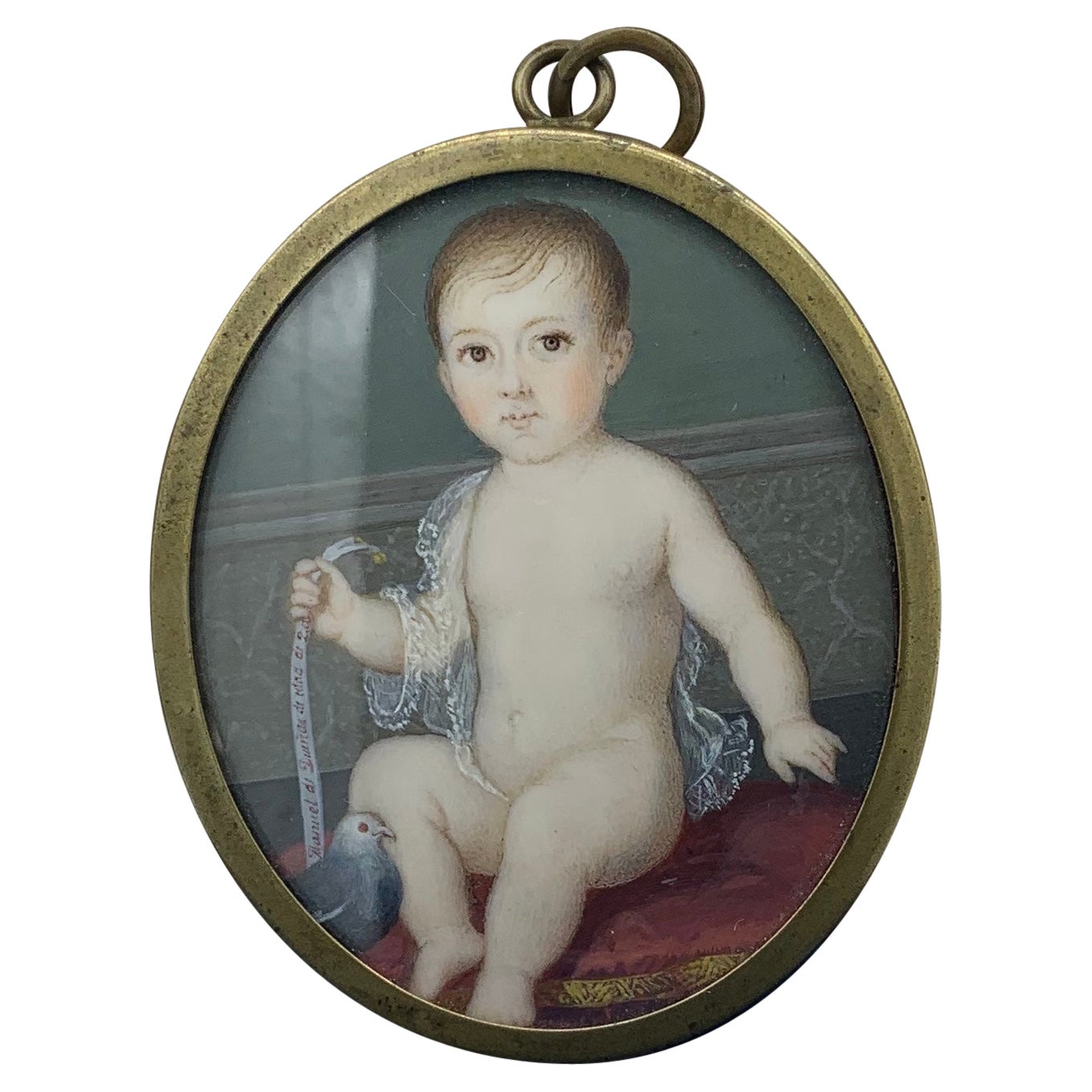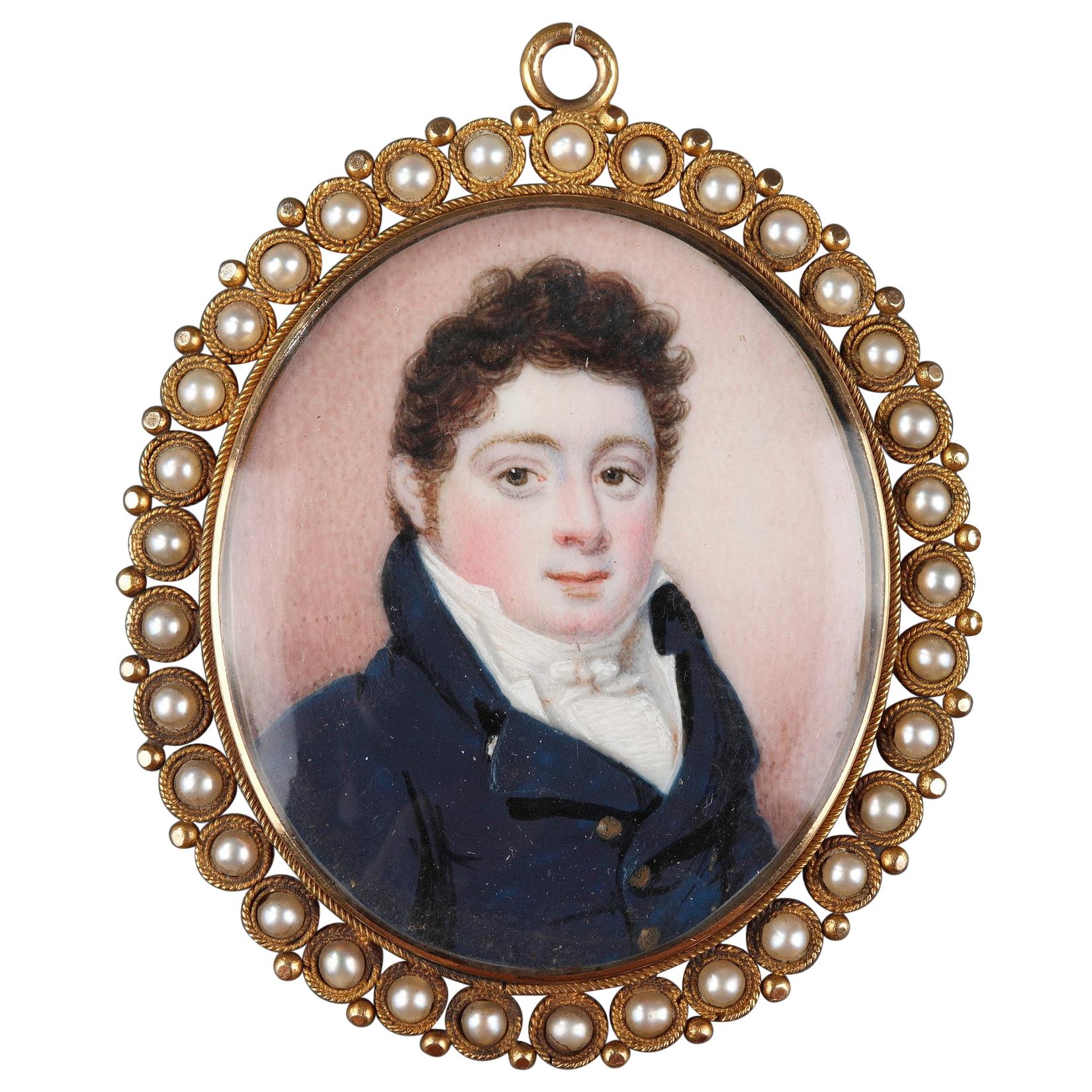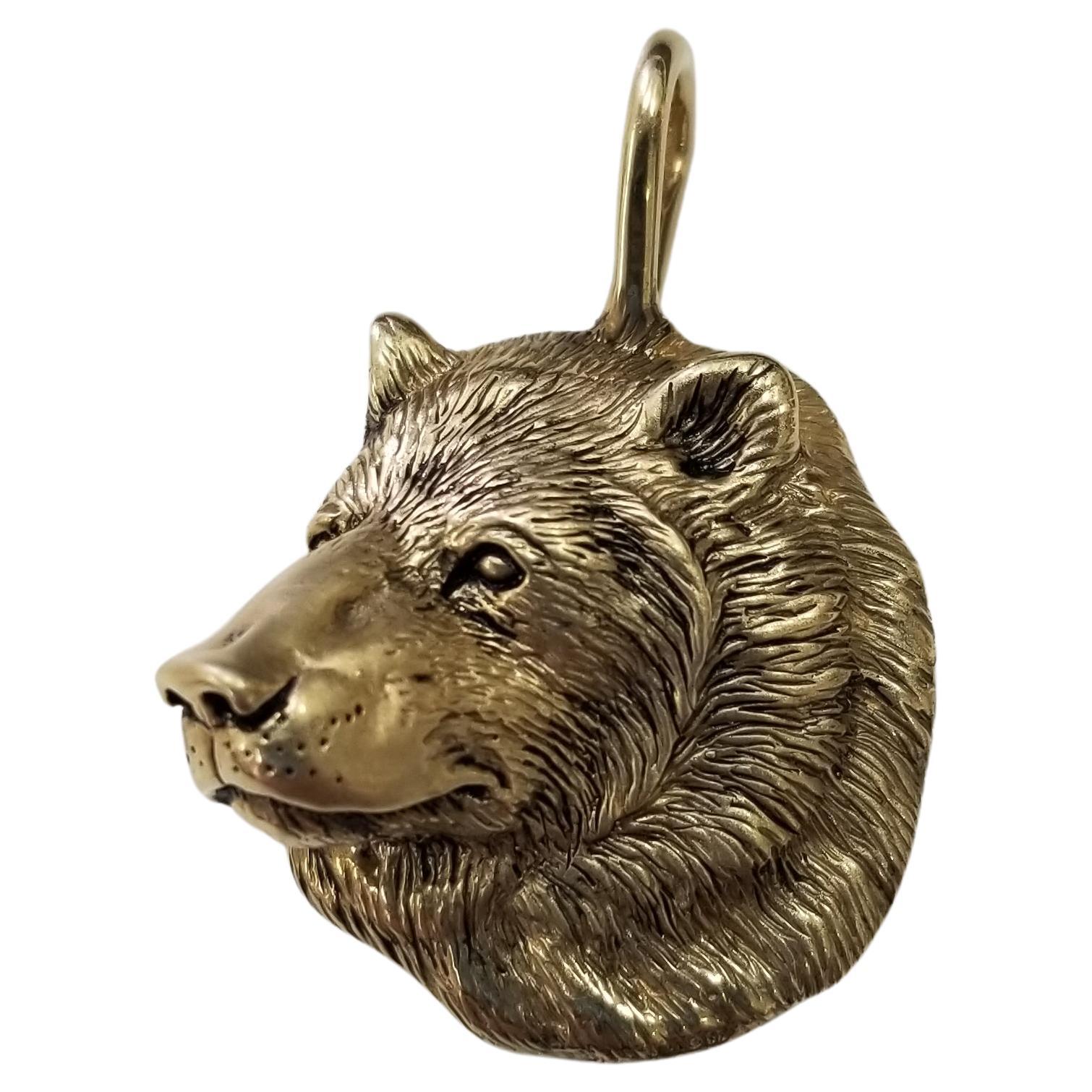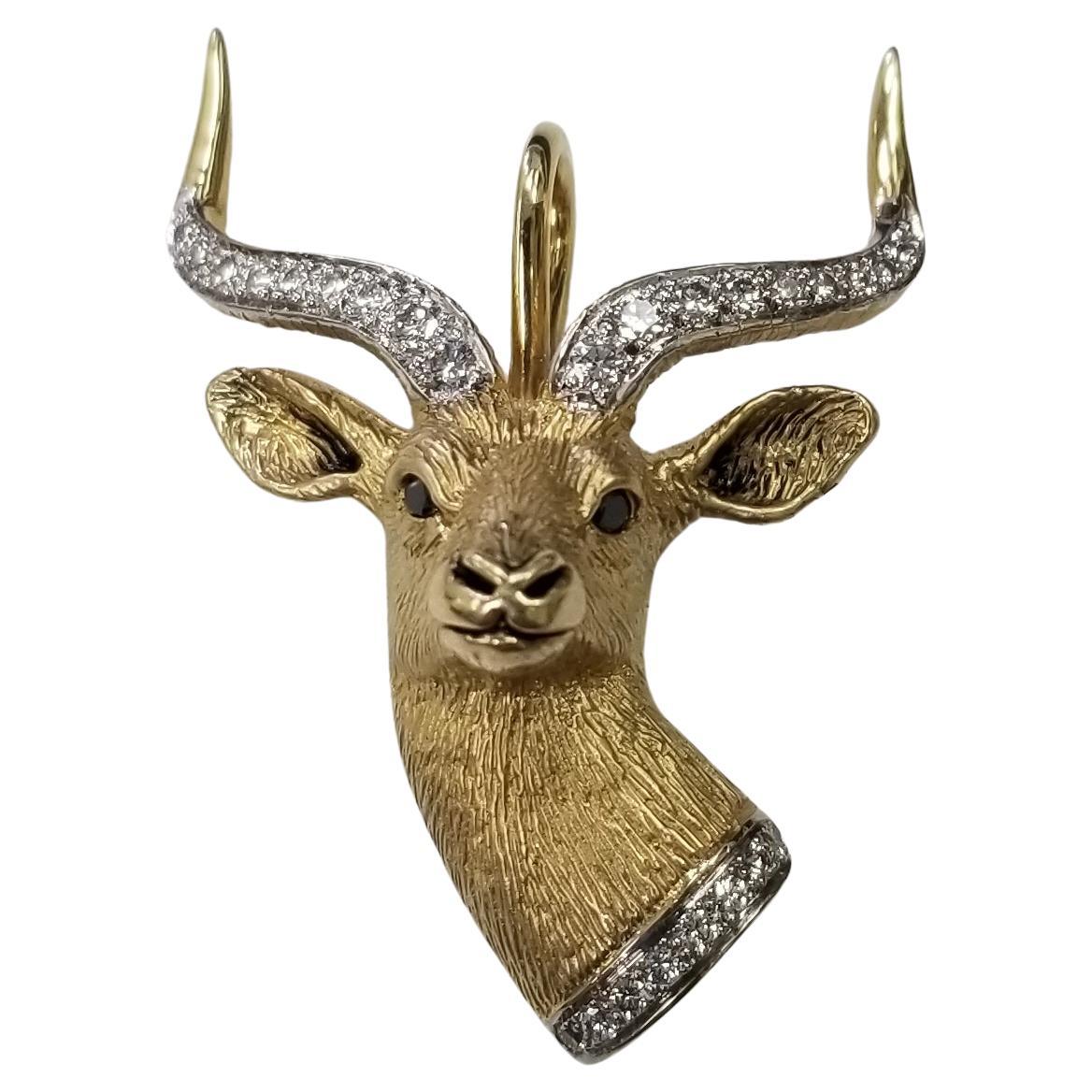Items Similar to Antique Reliquary Book Pendant Locket
Video Loading
Want more images or videos?
Request additional images or videos from the seller
1 of 8
Antique Reliquary Book Pendant Locket
About the Item
RELIQUARY PENDANT IN BOOK FORM
Probably southern Germany, 1630–40
Gilded silver, verre églomisé
Weight 13.2 grams; dimensions 42 × 25 × 12 mm; opens to 40 mm
Gilded silver pendant in book form with hinged, lid, corded wire surround, and engraved spine. The front cover of the book is set with a plaque depicting Moses receiving the Law in verre églomisé, and the back cover shows the Sacrifice of Abraham. The scenes are in gold against a red background. When opened, the book reveals two portraits, probably of a husband and wife, wearing seventeenth-century dress. The costumes suggest a date c. 1630-40; the wife holds a daisy. Trefoil-shaped pendant loop on top and bottom, and book clasp.
As in the scenario described for the assemblage of these pendant miniature books (see no. 34), this book may have satisfied the desires of a particular patron, perhaps even one of the Jewish faith. The images that have been chosen for the four verre églomisé inserts are somewhat unusual within the group of comparable objects; on the front is Moses, on the back is the Sacrifice of Isaac. On the inside, instead of an iconic or doctrinal image, one sees portraits of the patron and his wife, in their finest dress, contents reminiscent of a modern locket with photographs of loved ones enclosed.
The image of Moses on the front of the book/locket depicts the prophet kneeling before the tablets of the Law and in front of the flaming branches of the burning bush. Moses is speaking with God, gesticulating with a pointing index finger, and looking up to a figure in a bank of clouds above who gestures back. The “horns” that were typical in representations of Moses during this period derived from a mistranslation of the biblical text describing the prophet’s head as surrounded by rays of light (Exodus 34:29).¹ Here his figure glows in gold against red, delineated with fine black lines.
The scene of the Sacrifice of Isaac, illustrated on the book’s back cover is, of course, the great biblical demonstration of unquestioning faith. Abraham raises his sword to kill his son as he has been instructed to do by God, while the angel descending from heaven stops the blade just before it can swing down to behead the boy.
Inside the book, in contrast to these momentous biblical statements of faith and prayer, we find a very different sort of scene that requires a different sort of looking. Here we are asked to gaze in approval upon a couple, their portraits perhaps included in this object as a commemoration of their marriage. The couple are obviously wealthy, and hold objects and wear clothing that reinforce the perception of their status.
The man has a fine and prominent white lace collar and a sword with a very large and elaborate pommel, attached to his person by a prominent belt. The wife stands demurely, holding a flower. In this case, the interior of the little book might have held nothing at all or perhaps it held some sort of personal memento or tiny scrap of paper or parchment with a meaningful text.
A surviving design by Hans Holbein the Younger (1497/98–1543) for a book pendant for Thomas Wyatt and his wife, Jane, undoubtedly created when the artist was at the Tudor court in the second and third decade of the sixteenth century, derives a pattern from the patron’s initials. This sort of design, with no religious reference at all, speaks not only to the popularity of book jewels but also to their potential use as markers of identity.
Surely this sort of object, even if it was created in commemoration of a marriage, as were so many double portraits, would have been an especially precious family heirloom. Descendants could treasure it for its religious significance and for its value, and on occasion would have opened it to remember and mourn their deceased ancestors.
Provenance: Collection of Liuba (1923-2005) and Ernesto (1918-2003) Wolf; their sale. Paris, Artcurial, 1 December 2014, lot 86. They were major collectors of modern and tribal art and antiquarian books and donated their collection of Byzantine and medieval glass to the Landesmuseum Württemberg, Stuttgart.
Comparisons and Literature: This fine painting on a miniature scale in verre églomisé with a generous use of gold foil and deep red and blue colors is typical for the Lombardy region beginning in the latter half of the sixteenth century, see Ryser/Salmen 1997, pp. 68 ff. For the technique, see Ryser 1991, pp. 13 ff. The plaques are from this early period. Pendants with similar verre églomisé scenes of the Crucifixion can be found in the Walters Art Museum, Baltimore (Scarisbrick 1978, nos. 498-99); Bayerisches Nationalmuseum, Munich (Knaipp 1988, p. 46); Museo Regionale Pepoli, Trapani (di Natale 1989, fig. 37); for John the Baptist, see Metropolitan Museum of Art, New York, inv. no. 17.190.908).
- Metal:
- Weight:13.2 g
- Dimensions:Width: 0.99 in (25 mm)Depth: 0.48 in (12 mm)Length: 1.66 in (42 mm)
- Period:Mid-17th Century
- Date of Manufacture:1630-1640
- Condition:Wear consistent with age and use.
- Seller Location:Chicago, IL
- Reference Number:
About the Seller
5.0
Vetted Seller
These experienced sellers undergo a comprehensive evaluation by our team of in-house experts.
Established in 1991
1stDibs seller since 2021
5 sales on 1stDibs
Typical response time: 16 hours
- ShippingRetrieving quote...Ships From: Chicago, IL
- Return PolicyA return for this item may be initiated within 3 days of delivery.
More From This SellerView All
- Renaissance Reliquary Pendant with Pearl and EnamelingLocated in Chicago, ILRELIQUARY PENDANT WITH PEARL Spain or Spanish Netherlands, c. 1620 Gold, rock crystal, enamel, pearl, bone relics Weight 12.9 grams; dimensions 40 ...Category
Antique 1620s Spanish Renaissance Pendant Necklaces
MaterialsPearl, Gold, Enamel
- Late Renaissance Octagonal Gilded Brass Reliquary Pendant with Velvet InteriorLocated in Chicago, ILOCTAGONAL RELIQUARY PENDANT Probably Italy, c. 1600 Fire-gilded brass, glass, velvet, ink on paper Weight 63.2 grams; dimensions 82 × 47 × 21 mm (with loop) Physical description: Double-sided pendant in octagonal form made of fire-gilded brass. Both sides of the pendant with deep profiled frames with glass. The slightly indented side panels comprise openwork friezes with symmetrical scrollwork. On the front is dark red velvet, onto which tiny bone relics of saints (now missing) would have been attached. Labels on a lace-like paper silhouette remain, with names written in ink, mostly faded; only “S. Agnes” is legible. The back is hinged and when opened reveals a velvet-lined interior and paper insert with floral decorations on a turquoise ground, on which fragments of bones are attached. Baluster shaped base for shield-like pendant loop and ring. This reliquary pendant is difficult to situate historically because it is a composite object. It represents traditional handwork in the form of a paper cutout, combined with a jeweler’s beautiful fire-gilt brass case. The work of paper cutting, painting, and ornamentation, sometime combined with needlework, is comparable to work still being done in the nineteenth century by nuns and pious ladies. It is prayerful work, a devotional exercise in itself, and shows reverence to the tiny relic fragments that it would have framed and honored. Early versions of this sort of handiwork might be found in the meticulous displays sometimes called “Paradise Gardens.” These were made, beginning in the sixteenth century, by the nuns at Mechelen, in northern Belgium, in multimedia handwork displays of sewing and gluing, combining relics with paper, cloth, glass, metal wire, and found materials. These textured and pious displays were then combined with paintings and cases by professional artists and artisans, as in the example in Cassel. Unfortunately, because of water damage, only one of the labels of the original relic displayed in this reliquary is legible, inscribed “S. Agnes” at the center top; the other names are faded. Presumably the deep velvet-lined box would have also held an assortment of relics other than the ones that were visible through the glass, and perhaps there would have been another display in the glass on the other side of the pendant. There is a second paper insert, this one decorated with a turquoise ground and silhouette flowers to which bone fragments seem to be still attached. The octagonal case, in contrast to the paper cutout, is not at all “home-made.” It has an openwork frieze in scrollwork patterns familiar from enamel work and other metalwork done for European courts and nobility. It is not unlike cases for expensive watches...Category
Antique Early 1600s Italian Pendant Necklaces
MaterialsBrass
- Antique Architectural Rock Crystal PendantLocated in Chicago, ILROCK CRYSTAL PENDANT WITH COLUMN France or Italy, 16th century Fire-gilded silver, rock crystal, verre églomisé Weight 96 grams; dimensions 75 × 35 × 21 mm (with loop) Architec...Category
Antique 16th Century Medieval Pendant Necklaces
MaterialsCrystal, Rock Crystal, Gilt Metal
- Fifteenth Century Reliquary Pendant with Christ on the CrossLocated in Chicago, ILReliquary Pendant with Christ on the Cross Germany, c. 1480–1500 Gilded silver Weight 35 grams; dimensions 69 × 46 × 8 mm A mixture of forms gives t...Category
Antique 15th Century and Earlier German Figurines and Sculptures
MaterialsSilver, Gilt Metal
- Antique Spanish Jet Amulet Pendant with FigaLocated in Chicago, ILAMULET PENDANT WITH FIGA Spain, c. 1620–1630 Jet, silver, and enamel Weight 60.7 grams; dimensions 85 × 49 × 18 mm Large pendant in the shape of a hand carved from jet with a clinched fist in the figa (Spanish higa) gesture. In the palm of the hand is a heart carved in relief and on the back a six-ray star in a circle. The silver mount covers the wrist like a cuff and is decorated with a frilled border, and on the front with collet-set bosses with silver C-scrolls against blue enamel; on the back is a roundel in relief with floral motif. Domed base for the pendant loop in pea-pod form. The figa (also fica or higa) represents an age-old symbol of protection against the evil eye and other demonic threats. Its origins were pagan and buried deep in antiquity. Roman examples, such as one found recently in an archeological excavation in London, also make it clear that the protective qualities are based in a sexual symbolism–particularly the power of the phallus. The Roman bone figa/phallus in effect represents the phallus twice; that is, the gesture made by the figa hand is generally explained as fingers representing the female genitalia (vulva) penetrated by the phallus of the thumb. But other interpretations are less specific, including explanations that the left hand is the feminine principle, and the right hand is the masculine. In Spain, jet figa are common; we see one in the portrait of Anne of Austria the infanta (p. 75). That is not to say that the objects are not sumptuous or treasured. Jet was a very valuable material, and in many examples like this one, the figa is embellished with beautiful enameling or is even gem-studded. Comparable objects occur in equally sumptuous materials such as rock crystal. The enameled setting allows a dating of these objects that otherwise might prove difficult, given that the production of such objects in Spain is so consistent over centuries. Indeed, there is another, even more elaborately carved example in this collection, attached to the “magic belt” (no. 9). That example may belong to an earlier group. That figa includes deeply excavated carving, including on the upper surface, an M-shaped design that Walter Leo Hildburgh links to the heart shape (as it occurs more explicitly on this example). Hildburgh argues that its presence is especially common on these objects and that it originally represented the Sacred Heart of Mary...Category
Antique Early 17th Century Spanish Pendant Necklaces
MaterialsSilver
- Antique Gold Pendant with Diamonds and PearlsLocated in Chicago, ILPendant with Virgin Mary as Queen of Heaven Western Europe, Southern Germany (?), Italy (?), c. 1550-1560 Gold, enamel, diamonds, and pearls Weight 13.2 gr; Length 36.9 x 31.2 mm (incl. pearls) This sumptuous image exudes regal power. It portrays the Virgin Mary as Queen of Heaven wearing a dress and crown studded with seven large diamonds and set against a translucent, rich blue celestial background. Far removed from the tender, humble Virgin seen in German and Netherlandish artworks of the period, she is a majestic ruler, mouth sternly set, head tilted upward, and face in full profile. The oval pendant cast in high gold relief with a central medallion, the single figure filling the space, echoes jewelry portraits of the aristocracy during the Renaissance, which similarly offset the ruler’s image against a blue field composed of enamel or lapis lazuli, symbolic of divine power Only the rays of the shining gold halo that emerge behind the Virgin’s head and her long flowing hair (instead of neatly coiffed) distinguish her from female ruler portraits of the period. Three studded pearls, forming an axis, also recall pendants of European rulers. Wealth, royal status, and divine power come together in this opulent pendant. Portraits of the period show similar small oval pendants worn by women in the square of the garment or by men nestled inside multiple chains below the base of the neck. PROVENANCE European Private Collection LITERATURE Compare images from ancient Rome, for example a sardonyx cameo with female head (Kugel 2000, no. 18; Milan, c. 1550), and a pendant with gold, pearls, and enamel in the Staatliche Museum Kassel (Schmidberger/Richter 2001, no. 43; France, c. 1555-1560). For ruler pendants with blue backgrounds see a pendant of King Frances I...Category
Antique 16th Century Pendant Necklaces
MaterialsDiamond, Pearl, Gold
You May Also Like
- Georgian Child Dove Bird Locket Pendant Portrait Miniature Necklace Hand PaintedLocated in New York, NYThis is a very early and rare Museum Quality Georgian Locket Pendant Necklace with an extraordinary hand painted portrait miniature of a child with a d...Category
Antique Early 19th Century Unknown Georgian Pendant Necklaces
MaterialsGilt Metal
- Georgian Child Flower Locket Pendant Gold Portrait Miniature NecklaceLocated in New York, NYThis is a very early and rare Museum Quality Georgian Locket Pendant Necklace with an extraordinary hand painted portrait miniature of a child in a fie...Category
Antique Early 19th Century Unknown Georgian Pendant Necklaces
MaterialsGold, 10k Gold, Rose Gold
- Falcon Yellow Gold 18 Karat Pendant Charm PendantLocated in Geneva, CHFalcon Yellow Gold 18k Pendant Charm Pendant. Total length: 1.38 inch (3.50 centimeters) including bail. Total weight: 8.24 gramsCategory
Mid-20th Century Models and Miniatures
MaterialsYellow Gold
- Louis-Philippe Pendant "Souvenir" with MiniatureLocated in Paris, FRA gold-mounted pendant with a mother-of-pearl medallion depicting the portrait of a young dandy on light pink background, framed with pearls. On the back, locks of hair attached with...Category
Antique 1840s French Pendant Necklaces
MaterialsPearl
- Madleine Kay 14k Yellow Gold "Bear Head" pendantLocated in Los Angeles, CAMadleine Kay 14k Yellow Gold "Bear Head" pendant Specifications: brand: custom metal: 14K yellow gold type: Pendant weight: 8.5 gr. *Madl...Category
21st Century and Contemporary American Artisan Pendant Necklaces
MaterialsYellow Gold, 14k Gold
- Madleine Kay 14k Yellow Gold "Impala Head" Pendant with DiamondsLocated in Los Angeles, CAMadleine Kay 14k Yellow Gold "Impala Head" pendant with Diamonds Specifications: main stone: diamonds .48pts. brand: custom metal: 14K yellow...Category
21st Century and Contemporary American Artisan Pendant Necklaces
MaterialsDiamond, 14k Gold, Yellow Gold
Recently Viewed
View AllMore Ways To Browse
Antique Jewellery Group
Antique Jewelry Group
Swing Collar
Large Antique Locket
Large Antique Lockets
Flower Locket
Large Locket Necklace
Antique Silver Locket Necklace
Antique Engraved Gold Locket
Antique Collar Necklace
Antique Lace Designs
Black And Gold Lockets
Antique Initial Necklace
Baltimore Antiques
Antique Locket Fine
Museum Of Modern Art Jewelry
Antique White Gold Locket
Flower Gold Locket





